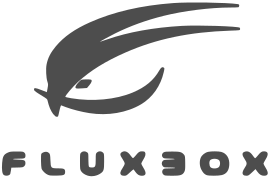Fluxbox桌面环境
Fluxbox是一个基于GNU/Linux的类Unix系统轻量级图形桌面操作界面,它虽然没有GNOME和KDE那样精美,但由于它的运行对系统资源和配置要求极低,所以它被安装到很多较旧的或是对性能要求较高的机器上,其菜单和相关配置被保存于用户根目录下的.fluxbox目录里,这样使得它的配置极为便利。采用C++语言开发并在MIT许可证协议下授权使用。
其运行速度相当快并基于Blackbox并与之相兼容,这两者的窗体控件,色调等都极为相似。Fluxbox对KDE、Xfce、Gnome的程序支持也很不错。并且,它不需要借用其他的窗口管理器。
Fluxbox is a windowmanager for X that was based on the Blackbox 0.61.1 code. It is very light on resources and easy to handle but yet full of features to make an easy, and extremely fast, desktop experience.

Fluxbox是一个X窗口管理器,并分叉自Blackbox 0.61.1。它的目标是轻量级和可定制。所有的基本配置通过文本文件来控制。它的用户界面仅有一个任务栏与右键弹出式菜单。
Fluxbox默认的界面极为简洁,只有一个工具栏,并通过右键来调用系统菜单,同样它也支持自定义快捷键。它有一个很出色的窗体标签功能,可以通过鼠标中键拖拽将几个不同的窗体组合到一个窗口上,利用这个功能就可以把一大堆的程序窗口整理得井井有条,哪怕把所有的窗体都放在同一个workspace里面。其另一个很不错的功能就是支持dock程序,这种程序运行时会像桌面图标一样在桌面上显示(比时一些时钟、天气、日历、系统监视程序),由于Fluxbox至力于打造一个快速和高定制性的图形系统,所以它只提供了一些最基础的图标和主题。
其界面朴素简单的风同样也体现在它的系统设置上。它的系统菜单,快捷键和其他的一些基本设置都是以文本文件的形式来保存的。Fluxbox的外观主题100%兼容blackbox,并且其主题的色彩,透明度,窗体边框及其他一些可视组件都可以个性化定制,最新发布的几个版本还实现了边框的圆滑效果和背景图支持;与blackbox相比,Fluxbox增加了一些特性,比如窗体标签(这是从PWM一些特性上吸收并改进过来的)和可定制的窗体标题栏。
Feature
APPS-FILE
One of the most underestimated - although one of the most powerful features - is the apps-file. With this file it is possible to set application-specific parameters for dimension, decoration, default workspace to open on, stickyness and much more. It will let you manipulate almost every setting for any window or application. The best way to learn about it is to visit the wiki-site for the apps-file.
KEYS-FILE
The keys-file does not only provide comfort to people who have no mouse, it also makes working more comfortable for all users. Setting up a proper keys-file lets you control almost everything and is a lot faster than from using a menu with only keys, key.combinations and key-chains. People who do not like to raise their hands from the keyboard to grab the mouse and people who do not let lose their rodent will love the keys-file for being fully customizable to one's needs and workflow. Learn more about the keys-file in the wiki.
TABS
Tabbing is a nice feature that allows you to tab windows together. This can be combined with the "autogrouping" feature that is provided via the apps-file. This will make certain applications tab together by default.
Tabs can eiher be embedded into the window's titlebar as shown in the upper screenshot or they can appear as little tabs at the outside of a window such as the lower example. The position and size of the outside-tabs is customizable.
SLIT
The Slit is often confused with the toolbar. The slit is a dock for any application that can be 'dockable'. A docked application is anchored and appears on every workspace. It cannot be moved freely and is not influenced by any manipulation to windows. Typical programs that go into the slit are dockapps or gkrellm. The latter one is shown in the litte example shot.
ROOT-MENU
The Root-Menu is the menu that appears on a right click on the desktop. It is fully customizable and implies a lot of native features such as a configure-menu, a style-menu, and many custom menus can be used and included. Learn more about the menu-file in the wiki.
TOOLBAR
The Toolbar is the bar down at the bottom by default that shows all the windows on the desktop. According to its configuration the user can define what windows are shown. It also contains helpful tools such as the current workspace-name, a clock, the systemtray and some buttons to switch between workspaces/windows. Learn how to customize the toolbar.
SYSTEMTRAY
The Systemtray is a little tool of the toolbar that can pick up applications that provide such feature. Applications sit as little icons in the systemtray.
最新版本:1.3
官方主页:http://www.fluxbox.org/
其运行速度相当快并基于Blackbox并与之相兼容,这两者的窗体控件,色调等都极为相似。Fluxbox对KDE、Xfce、Gnome的程序支持也很不错。并且,它不需要借用其他的窗口管理器。
Fluxbox is a windowmanager for X that was based on the Blackbox 0.61.1 code. It is very light on resources and easy to handle but yet full of features to make an easy, and extremely fast, desktop experience.

Fluxbox是一个X窗口管理器,并分叉自Blackbox 0.61.1。它的目标是轻量级和可定制。所有的基本配置通过文本文件来控制。它的用户界面仅有一个任务栏与右键弹出式菜单。
Fluxbox默认的界面极为简洁,只有一个工具栏,并通过右键来调用系统菜单,同样它也支持自定义快捷键。它有一个很出色的窗体标签功能,可以通过鼠标中键拖拽将几个不同的窗体组合到一个窗口上,利用这个功能就可以把一大堆的程序窗口整理得井井有条,哪怕把所有的窗体都放在同一个workspace里面。其另一个很不错的功能就是支持dock程序,这种程序运行时会像桌面图标一样在桌面上显示(比时一些时钟、天气、日历、系统监视程序),由于Fluxbox至力于打造一个快速和高定制性的图形系统,所以它只提供了一些最基础的图标和主题。
其界面朴素简单的风同样也体现在它的系统设置上。它的系统菜单,快捷键和其他的一些基本设置都是以文本文件的形式来保存的。Fluxbox的外观主题100%兼容blackbox,并且其主题的色彩,透明度,窗体边框及其他一些可视组件都可以个性化定制,最新发布的几个版本还实现了边框的圆滑效果和背景图支持;与blackbox相比,Fluxbox增加了一些特性,比如窗体标签(这是从PWM一些特性上吸收并改进过来的)和可定制的窗体标题栏。
Feature
APPS-FILE
One of the most underestimated - although one of the most powerful features - is the apps-file. With this file it is possible to set application-specific parameters for dimension, decoration, default workspace to open on, stickyness and much more. It will let you manipulate almost every setting for any window or application. The best way to learn about it is to visit the wiki-site for the apps-file.
KEYS-FILE
The keys-file does not only provide comfort to people who have no mouse, it also makes working more comfortable for all users. Setting up a proper keys-file lets you control almost everything and is a lot faster than from using a menu with only keys, key.combinations and key-chains. People who do not like to raise their hands from the keyboard to grab the mouse and people who do not let lose their rodent will love the keys-file for being fully customizable to one's needs and workflow. Learn more about the keys-file in the wiki.
TABS
Tabbing is a nice feature that allows you to tab windows together. This can be combined with the "autogrouping" feature that is provided via the apps-file. This will make certain applications tab together by default.
Tabs can eiher be embedded into the window's titlebar as shown in the upper screenshot or they can appear as little tabs at the outside of a window such as the lower example. The position and size of the outside-tabs is customizable.
SLIT
The Slit is often confused with the toolbar. The slit is a dock for any application that can be 'dockable'. A docked application is anchored and appears on every workspace. It cannot be moved freely and is not influenced by any manipulation to windows. Typical programs that go into the slit are dockapps or gkrellm. The latter one is shown in the litte example shot.
ROOT-MENU
The Root-Menu is the menu that appears on a right click on the desktop. It is fully customizable and implies a lot of native features such as a configure-menu, a style-menu, and many custom menus can be used and included. Learn more about the menu-file in the wiki.
TOOLBAR
The Toolbar is the bar down at the bottom by default that shows all the windows on the desktop. According to its configuration the user can define what windows are shown. It also contains helpful tools such as the current workspace-name, a clock, the systemtray and some buttons to switch between workspaces/windows. Learn how to customize the toolbar.
SYSTEMTRAY
The Systemtray is a little tool of the toolbar that can pick up applications that provide such feature. Applications sit as little icons in the systemtray.
最新版本:1.3
官方主页:http://www.fluxbox.org/
该文章最后由 阿炯 于 2024-12-19 14:08:37 更新,目前是第 2 版。
